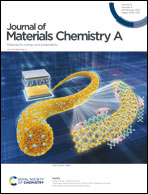Phosphorus-modified ruthenium–tellurium dendritic nanotubes outperform platinum for alkaline hydrogen evolution†
Abstract
The hydrogen evolution reaction (HER) is an important process in electrochemical water splitting, and the key factor for HER technology lies in the development of cost-effective and highly efficient electrocatalysts. Herein, phosphorus (P)-modified ruthenium (Ru)–tellurium (Te) dendritic nanotubes (RuTeP NTs) are prepared via a facile two-step synthetic strategy using Te nanowires as the starting materials. The RuTeP NTs display excellent catalytic performance for the HER in alkaline media with an overpotential of only 35 mV at a cathodic current density of 10 mA cm−2, which is even superior to that of the commercial Pt/C catalyst. Detailed investigations indicate that the modification with P can improve the electrocatalytically active surface area and electron transfer capability and together with Te, modify the electronic structure of Ru atoms, which synergistically promote the HER electrocatalysis. The present work may open a new avenue to construct P-modified electrocatalysts with a rational design morphology and structure for water splitting or other electrocatalytic reactions.



 Please wait while we load your content...
Please wait while we load your content...